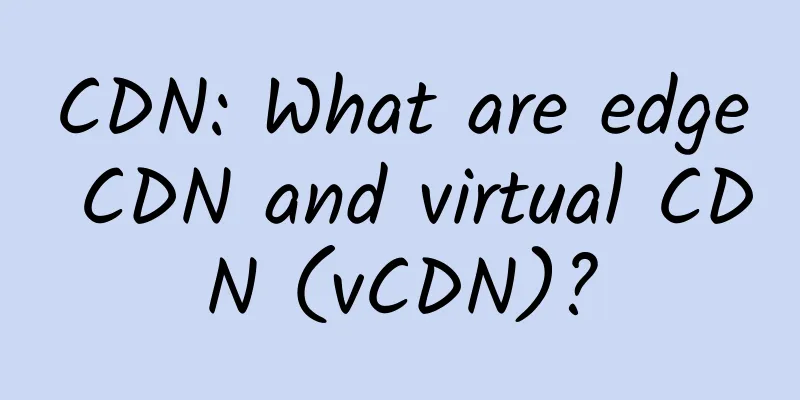CDN: What are edge CDN and virtual CDN (vCDN)?

|
What are the limitations of CDN today? Today, content and game providers are under increasing pressure to deliver fast, high-quality content streams to end users while meeting localized, distributed demand peaks. To some extent, these demands can be met through content delivery networks (CDNs). However, most CDN infrastructure today does not have the scalability and flexibility required for content caching and delivery to meet future demands. Currently, most CDN servers are located in PoP points or distributed data centers in IXPs, and content can be cached closer to end users, so that some content does not need to access the central source server, but can be cached in distributed servers. However, the distribution of these servers is too centralized, so that content and game providers cannot ensure a high quality of experience (QoE) for end users in the face of growing demand. How do edge CDNs and vCDNs address these limitations? To overcome the limitations of existing CDN capabilities and meet future needs, two key trends have emerged: edge CDN and virtual CDN (vCDN). Edge CDN Edge CDN enables a wider distribution of CDN servers. Today, most CDN functions are implemented at IXPs, but these functions are increasingly being moved to edge nodes of mobile networks. Edge CDNs can be deployed locally, such as on university campuses or airports, where there is a high demand for local streaming, and most deployments will be located in the core nodes of the mobile network (internal edge), or in the RAN (external edge). vCDN vCDN is a virtualized CDN software application that can run CDN workloads on dedicated, bare metal, virtualized or container-based infrastructure, or on a telecom operator's MEC platform. Previously, CDN software platforms were tightly coupled to the underlying hardware and lacked flexibility. vCDN may be deployed at the CDN PoP of an IXP, or it may appear in the network or at a local edge site. Edge CDN and vCDN each have unique advantages that enable content and game providers to cache more content and flexibly run CDN functions on shared servers to address demand peaks or when users access content anytime, anywhere. Edge CDN has three main advantages:
Although vCDN can enhance the functionality of IXP PoPs, its benefits are more evident at the edge, where vCDN adds additional scalability and flexibility on top of the benefits of edge CDN:
Although most edge CDN deployments will be virtualized and run on open, shared infrastructure, some providers prefer a proprietary vCDN model, where a virtualized software platform can run CDN workloads on the CDN provider's dedicated hardware, or run CDN functions on bare metal hardware. The benefit of a proprietary model is that CDN providers or large content providers with their own CDNs can bundle their solutions together for control without sharing infrastructure with other providers. In some cases, it is better to run the CDN directly on bare metal infrastructure because the virtualization layer consumes server capacity. In situations where high throughput is required and a large amount of data needs to be processed on one server, it may not make sense to use a virtualization layer. What is the CDN business model? There are two main business models for CDNs: commercial (generating revenue) and non-commercial (cutting costs and improving service quality). (1) Business Because CDNs are hosted in data centers or IXPs rather than in mobile networks, operators have historically been excluded from the business model dominated by providers such as Akamai and Limelight, which seek to generate revenue from CDNs and charge customers for using their servers. (2) Non-commercial For operators, the non-commercial model remains the main model for CDN. By caching content locally and reducing the backhaul traffic for high-bandwidth video content, creating capacity on the network, operators can improve customer experience and reduce operating costs. This model can also be adopted by large content providers, who may have their own CDN to optimize content quality but do not receive direct revenue from their CDN services. How will these business models change at the edge and enable mobile operators to monetize CDNs? These business models will also exist at the edge. There are two main edge models that can provide operators with more ways to generate revenue and provide partners for CDN solutions. (3) Shared location In addition to cost savings from improved network capacity, operators can also generate a small amount of revenue by providing facilities (including space, power and cooling) to vCDN solution providers or content providers, placing equipment at the edge: i.e., a co-located location. (4) Edge Platform In the edge platform model, operators can still generate revenue by improving network efficiency, but can also work with vCDN companies that provide services to content providers and earn revenue sharing by providing virtual computing infrastructure, or provide IaaS directly to content providers. vCDN solution providers are working with operators to explore the potential of the edge platform model and how to become key players in the edge CDN value chain. Telecom companies, hyperscale providers, and professional edge platform providers also have the opportunity to provide MEC platforms to enable content and vCDN applications to access edge resources. What does this mean for the future of content delivery? Both edge CDN and vCDN will change the content delivery landscape. Telecom operators have the opportunity to play a more important role in the CDN ecosystem and take advantage of new monetization opportunities. Some content and game providers have already partnered with vCDN platform providers to meet the changing needs of end users. Original link: https://stlpartners.com/edge-computing/cdn-what-is-edge-cdn-and-virtual-cdn-vcdn/ |
<<: Video and Network - Why is 700MHz the golden channel?
>>: Report: Amazon, Microsoft and Google account for half of all major hyperscale data centers
Recommend
What is the difference between China Telecom’s quantum encryption, quantum speed reading, and quantum energy bar?
[[377345]] Some time ago, China Telecom launched ...
How will the next generation of Wi-Fi change the smart home?
Strategy Analytics predicts that the number of Wi...
5G market is rapidly expanding and artificial intelligence scenarios are becoming a reality
[[183832]] In response to the explosive growth of...
80VPS: Japan/Hong Kong VPS annual payment starts from 299 yuan, Los Angeles VPS annual payment starts from 199 yuan
80VPS, a well-established Chinese hosting company...
OpLink: $3.50/month-AMD Ryzen/512MB/20GB NVMe/10Gbps ports
OpLink is a foreign hosting company founded in 19...
What is the use of airplane mode? What will happen if you don't turn it on when flying?
Everyone knows that when flying, you should turn ...
ReliableVPS: $33/year KVM-4GB/40GB/10TB/New York data center
ReliableVPS is a relatively new foreign VPS host....
CrownCloud: 2GB VPS in Los Angeles/Germany/Netherlands/Atlanta data centers starting at $5 per month
CrownCloud is a long-established foreign VPS host...
5G and the Internet of Things: A New Era of Digitalization
There is no doubt that 5G mobile networks will be...
The next generation of WIFI is here! Google applies for 6GHz WiFi testing, which is expected to be popularized in 2022
In the Wi-Fi world, 6GHz will be a major breakthr...
Advantages and Challenges of 5G Network Slicing
The fifth generation of mobile communication syst...
Automating network verification for smoother changes
Imagine a business-critical network that is runni...
Why is the 400-MHz spectrum ideal for critical communications?
The 400 MHz spectrum, with its long range, excell...
Extremely simple operation! IIS site migration can be achieved in 3 minutes
To achieve load balancing or server migration, we...
Security advantages and challenges of HTTP3 protocol
HTTP/3 is the third official version of the Hyper...









